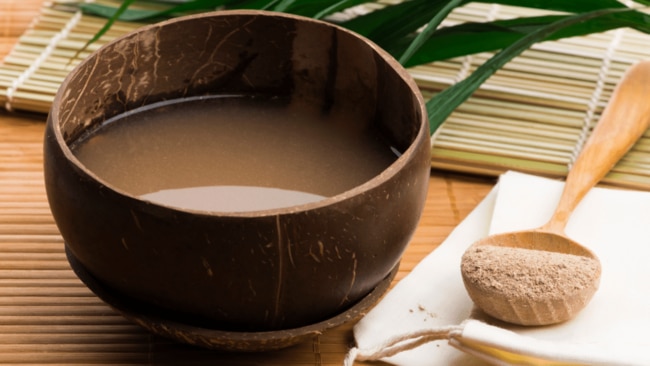The buzz for kava is growing - here's what you need to know
The latest way to chill out
Lifestyle
Don't miss out on the headlines from Lifestyle. Followed categories will be added to My News.
Beyond regulatory hurdles and certain misconceptions, kava is having a moment in the sun as we look for healthier alternatives to alcohol.
In an increasingly health conscious – yet anxious – world, and as young people cut back their alcohol use, kava’s time has come.
The plant-based recreational beverage kava appears to be growing in popularity and The Calmer Co. believes it can become a global phenomenon.
It is already massive – and getting bigger – in the US.
“Recreational beverage” … “alcohol replacement” … “mood enhancer” – more and more, these terms are being marketed to describe kava to the health-conscious among us.
Like what you see? Sign up to our bodyandsoul.com.au newsletter for more stories like this.
The drink, produced from the ground roots of the plant piper methysticum, specifically found in islands across the South Pacific, has for generations – thousands of years actually – been used socially, and for ceremonial cultural purposes in that beautiful part of the world.
It’s only in more recent times that global markets – particular the US, but also here in Australia – have begun to take a greater interest in the drink’s reported benefits, with enterprises such as The Calmer Co. marketing kava-based products as solutions to “calm nerves, support mind and muscle relaxation and induce sleep”.
In the US, meanwhile, kava bars have been spreading across the country as regulations surrounding the beverage relax in most states, and as younger demographics are shown to be consuming less alcohol – with some reports suggesting there are more than 500 kava-specific watering holes America-wide and growing.
In Australia, kava’s recent resurgence has come on the back of a long, and complex history – as Stockhead detailed in an August 2023 article – that ultimately saw the government lift an import ban in early 2022.
That was originally in place over concerns that overuse of kava was having detrimental social and health effects in some Indigenous communities.
To get more of a handle on the growing kava market, the buzz and misconceptions surrounding the drink and more, Stockhead caught up again with Anthony Noble, CEO of an Aussie firm with Fijian origins, The Calmer Co. – formerly known as Fiji Kava.

Calmer’s evolution
The Calmer Co. has enjoyed strong sales growth for its powdered kava drinks over the past several months, says Noble, through a hardworking eCommerce/online sales model, fervent marketing, as well as turning over increasingly good numbers through its placements in Coles supermarkets Australia-wide.
The big evolution for Calmer over the past year, notes Noble, is that it’s “taken the business from being focused on capsules and nutraceuticals sold through pharmacies and supermarkets to one that produces and sells functional beverages.
Those, explains Noble, are simply “drinks that do something for you”.
“And in the sense of our business, it helps people to sleep and unwind and relax. It can be considered really an alcohol replacement.”
There’s a buzz about kava – does it give one?
“Alcohol replacement” – does this mean, then that you can get a bit of a buzz from the products The Calmer Co. sells at Coles?
Without saying that specifically, Noble notes: “Kava, in general, has a really beautiful calming effect. It makes your mouth go numb and tingly when you drink it, and you do feel a little bit of a buzz.
“And then that relaxed effect, that’s similar to Xanax.
“It interacts with one of the cannabis receptors in the brain – a weak interactor with CB1 – so there’s a very slight similarity to cannabis, but nowhere near as intoxicating, and has the benefit of reducing anxiety.”
And presumably resulting in a distinct lack of need to consume eight pizzas with a side of Cheetos while attempting to make some sort of sense of David Lynch’s Eraserhead.
Negative perceptions and misconceptions
We’ve touched on some of kava’s purported health benefits, but we also asked Noble about some of the more negative perceptions kava’s faced. And are some or all of these, in fact, misconceptions?
“Kava can make you feel intoxicated if taken liberally. But if you drink too much, you just feel sleepy. You don’t get wobbly like being drunk,” said Noble.
“But there are a few major misconceptions around kava worth noting” he adds.
“There was a lot of negative publicity surrounding the drink regarding its use in Indigenous communities in Australia in the early 2010s when John Howard’s government placed a ban on kava.
“There’s a lot of misinformation about the misuse of kava in some communities.
“The reports that came out at the time were actually about people who where mixing kava with methylated spirits to create some sort of super cocktail.
“It was the methylated spirits that was actually hurting them.”
“Kava was actually originally introduced into Indigenous communities as a way to help create a shift away from alcohol.
“When prepared and consumed traditionally, as it is in the Pacific, it has none of the negative effects of alcohol.”
Noble also believes Calmer’s partnership with Coles helps to break down any lingering negativity surrounding Indigenous Australian connections with kava, in part due to the chain “being the largest employer of Indigenous people in Australia”.
“To get on the shelves at Coles, we had to go through all sorts of legal and regulatory doors, but we also had to get clearance through Coles’ Indigenous Affairs Committee,” he said.

And then, the other main misconception about kava, says Noble, is that it’s “something that could be potentially dangerous to consume”.
He refers specifically to reports in the early 2000s in Germany about a supposed connection to liver damage – which have since been debunked, he says.
“In fact, the World Health Organisation has since released a ‘codex’ confirming that kava is completely safe,” Noble said.
“But that preconception about kava and liver damage persists all over the internet. It’s a lot of effort and we’re working really hard to educate people that it’s simply not true. It did hit the industry really hard.”
Why kava could boom
Persistent misconceptions aside, then, why is now the time for a kava boom?
The cumulative effect of shifting consumer trends towards healthier lifestyles, that’s been happening for many years now, is a primary reason, says Noble.
And, in particular, he mentions the shift to lower consumption of alcohol that’s reportedly prevalent in younger generations coming through.
“Studies have shown that around about a third of people under 30, are just not drinkers,” Noble said. “That used to be more like about 2 to 5 per cent.
“There’s been this huge growth in younger people shifting away from consuming alcohol.
“It’s a massive demographic shift, and that’s backed up by all the low/no-alcohol product category growth.”
And on the health shift, “sleep and stress are two of the top categories of health focus at the moment,” added The Calmer Co. boss.
“I think the pandemic has also played a role. It did make more people begin to think about taking better care of themselves and dealing better with stress.”
Regulatory barriers
There are still significant regulatory barriers facing companies such as Calmer around the world for promoting and selling kava as a drink.
It’s still prohibited for sale across Europe, for instance, although Noble says he’s hearing some rumours that could change in the UK before too long.
The US, he says, provides a huge opportunity, however, and that’s partly because it’s less tightly regulated than, for instance, here in Australia and the Pacific.
“Over there, we can introduce things like different flavoured kava drinks. It’s definitely the No.1 market for kava at present.
“The trend towards it there is massive with kava bars all through Florida, Georgia, New York and up and down the west coast.”
The company is also dipping a toe cautiously into China, which could be another potentially huge market opportunity, once Australian and US opportunities are fully developed, says Noble.
This content first appeared on stockhead.com.au
Originally published as The buzz for kava is growing - here's what you need to know


